Examining clinical similarities between myalgic encephalomyelitis/chronic fatigue syndrome and D-lactic acidosis: a systematic review
- PMID: 28592308
- PMCID: PMC5463382
- DOI: 10.1186/s12967-017-1229-1
Examining clinical similarities between myalgic encephalomyelitis/chronic fatigue syndrome and D-lactic acidosis: a systematic review
Abstract
Background: The pursuit for clarity in diagnostic and treatment pathways for the complex, chronic condition of myalgic encephalomyelitis/chronic fatigue syndrome (ME/CFS) continues. This systematic review raises a novel question to explore possible overlapping aetiology in two distinct conditions. Similar neurocognitive symptoms and evidence of D-lactate producing bacteria in ME/CFS raise questions about shared mechanisms with the acute condition of D-lactic acidosis (D-la).
Methods: D-la case reports published between 1965 and March 2016 were reviewed for episodes describing both neurological symptoms and high D-lactate levels. Fifty-nine D-la episodes were included in the qualitative synthesis comparing D-la symptoms with ME/CFS diagnostic criteria. A narrative review of D-la mechanisms and relevance for ME/CFS was provided.
Results: The majority of neurological disturbances reported in D-la episodes overlapped with ME/CFS symptoms. Of these, the most frequently reported D-la symptoms were motor disturbances that appear more prominent during severe presentations of ME/CFS. Both patient groups shared a history of gastrointestinal abnormalities and evidence of bacterial dysbiosis, although only preliminary evidence supported the role of lactate-producing bacteria in ME/CFS.
Limitations: Interpretation of results are constrained by both the breadth of symptoms included in ME/CFS diagnostic criteria and the conservative methodology used for D-la symptom classification. Several pathophysiological mechanisms in ME/CFS were not examined.
Conclusions: Shared symptomatology and underlying microbiota-gut-brain interactions raise the possibility of a continuum of acute (D-la) versus chronic (ME/CFS) presentations related to D-lactate absorption. Measurement of D-lactate in ME/CFS is needed to effectively evaluate whether subclinical D-lactate levels affect neurological symptoms in this clinical population.
Keywords: Acidosis, lactic; Dysbiosis; Encephalomyelitis, myalgic; Fatigue syndrome, chronic; Microbiota-gut–brain; Neurological symptoms.
Figures
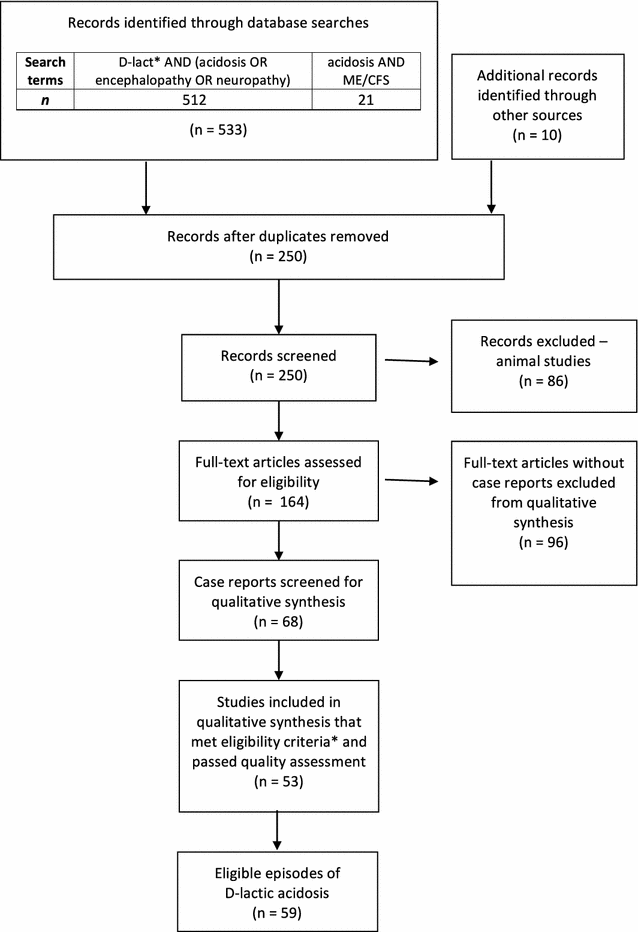
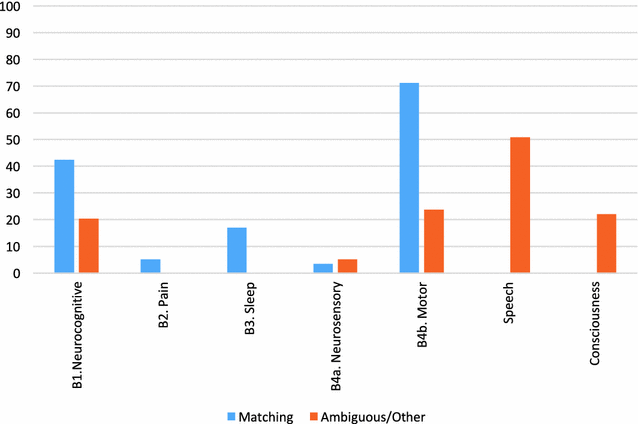
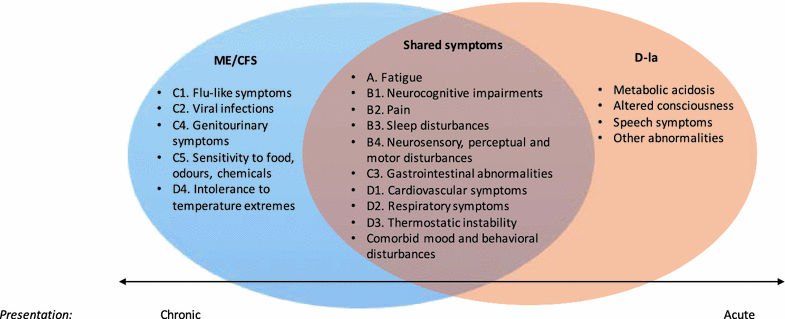
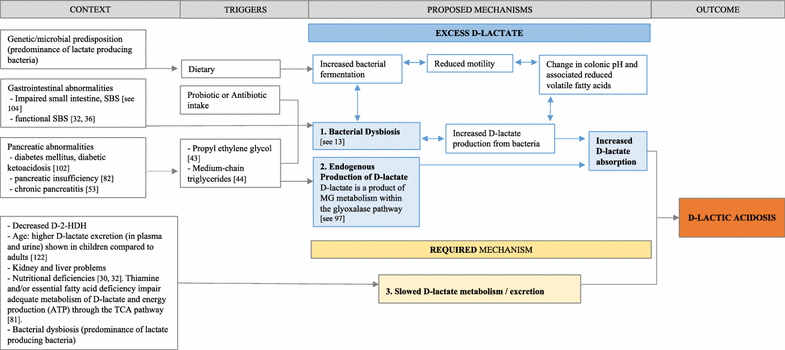
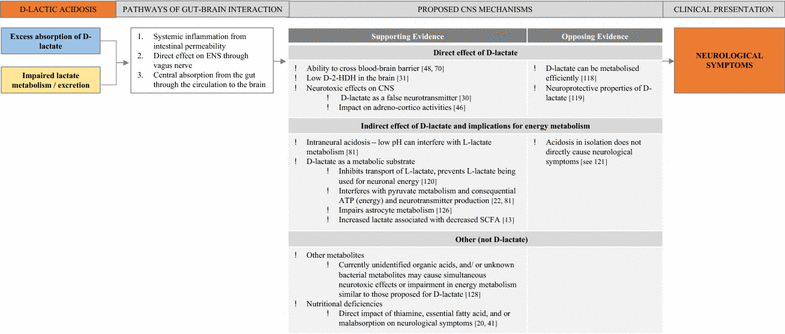
Similar articles
-
A systematic review of nutraceutical interventions for mitochondrial dysfunctions in myalgic encephalomyelitis/chronic fatigue syndrome.J Transl Med. 2021 Feb 17;19(1):81. doi: 10.1186/s12967-021-02742-4. J Transl Med. 2021. PMID: 33596913 Free PMC article.
-
Identifying commonalities and differences between EHR representations of PASC and ME/CFS in the RECOVER EHR cohort.Commun Med (Lond). 2025 Apr 11;5(1):109. doi: 10.1038/s43856-025-00827-5. Commun Med (Lond). 2025. PMID: 40210986 Free PMC article.
-
What treatments work for anxiety in children with chronic fatigue syndrome/myalgic encephalomyelitis (CFS/ME)? Systematic review.BMJ Open. 2017 Sep 5;7(9):e015481. doi: 10.1136/bmjopen-2016-015481. BMJ Open. 2017. PMID: 28877941 Free PMC article.
-
Diagnostic Methods for Myalgic Encephalomyelitis/Chronic Fatigue Syndrome: A Systematic Review for a National Institutes of Health Pathways to Prevention Workshop.Ann Intern Med. 2015 Jun 16;162(12):834-40. doi: 10.7326/M15-0443. Ann Intern Med. 2015. PMID: 26075754
-
Recovery from Exercise in Persons with Myalgic Encephalomyelitis/Chronic Fatigue Syndrome (ME/CFS).Medicina (Kaunas). 2023 Mar 15;59(3):571. doi: 10.3390/medicina59030571. Medicina (Kaunas). 2023. PMID: 36984572 Free PMC article.
Cited by
-
Worsening Symptoms Is Associated with Larger Cerebral Blood Flow Abnormalities during Tilt-Testing in Myalgic Encephalomyelitis/Chronic Fatigue Syndrome (ME/CFS).Medicina (Kaunas). 2023 Dec 12;59(12):2153. doi: 10.3390/medicina59122153. Medicina (Kaunas). 2023. PMID: 38138257 Free PMC article.
-
Open-label pilot for treatment targeting gut dysbiosis in myalgic encephalomyelitis/chronic fatigue syndrome: neuropsychological symptoms and sex comparisons.J Transl Med. 2018 Feb 6;16(1):24. doi: 10.1186/s12967-018-1392-z. J Transl Med. 2018. PMID: 29409505 Free PMC article. Clinical Trial.
-
Myalgic Encephalomyelitis/Chronic Fatigue Syndrome (ME/CFS): An Overview.J Clin Med. 2021 Oct 19;10(20):4786. doi: 10.3390/jcm10204786. J Clin Med. 2021. PMID: 34682909 Free PMC article. Review.
-
The potential role of ischaemia-reperfusion injury in chronic, relapsing diseases such as rheumatoid arthritis, Long COVID, and ME/CFS: evidence, mechanisms, and therapeutic implications.Biochem J. 2022 Aug 31;479(16):1653-1708. doi: 10.1042/BCJ20220154. Biochem J. 2022. PMID: 36043493 Free PMC article. Review.
-
Immune Signatures in Post-Acute Sequelae of COVID-19 (PASC) and Myalgia/Chronic Fatigue Syndrome (ME/CFS): Insights from the Fecal Microbiome and Serum Cytokine Profiles.Biomolecules. 2025 Jun 25;15(7):928. doi: 10.3390/biom15070928. Biomolecules. 2025. PMID: 40723800 Free PMC article.
References
-
- Sheedy JR, Wettenhall REH, Ssanlon D, Gooley PR, Lewis DP, McGregor NR, et al. Increased d-lactic acid intestinal bacteria in patients with chronic fatigue syndrome. In Vivo (Brooklyn). 2009;23:621–628. - PubMed
Publication types
MeSH terms
LinkOut - more resources
Full Text Sources
Other Literature Sources
Medical

